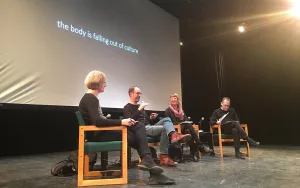In Tom Bessai’s engaging artist talk, he delves into the dynamic role of architects and designers amidst the advent of digital fabrication and technology. With a background in architecture and a deep involvement in technology, Bessai offers valuable insights into how these fields intersect and evolve.
Throughout his talk, Bessai covers a range of topics, starting with the essence of ideal digital fabrication projects, emphasizing the importance of geometry, order, and meaning. He then delves into the practicalities and challenges architects face, such as technology integration, workflow optimization, and the relationship between digital design and physical fabrication.
Another key aspect Bessai addresses is the emergence of a digital fabrication ecosystem, exploring how spaces, devices, and education intersect to shape the future of design and fabrication. He discusses issues like organization, accessibility, and the democratization of technology, envisioning a landscape where collaboration and experimentation thrive.
Bessai illustrates his points with examples from various projects and initiatives, showcasing innovative approaches to material testing, generative design, and machine feedback. He highlights the potential for collaboration between academia, industry, and the broader community, emphasizing the importance of shared spaces and resources in fostering creativity and innovation.
This presentation was part of the symposium Unhanded. In this panel we ask about the variety of new relationships with materials that emerging with the increasing ubiquitousness of digital technologies. With the increased complexity of tools we wonder how do we learn about materials? How do we get to know them? How do we share this knowledge? We can now know the molecular structure of wood or metal without touching it. Is this a more intimate relationship than working directly with our hands? Does it matter? If the objects coming out of digital and mechanical processes are more removed from our handywork, how might they carry the mark of the machine? Should we be able to read the machine in the material?
Tom Bessai, BA, BArch, MArch, OAA, MRAIC
Tom Bessai is a registered architect and an Assistant Professor at the Daniels FALD. He holds an MArch from UCLA and is completing a MSc from the University of Michigan’s Taubman College with a specialization in Design and Material Systems. His research and teaching explore computation and digital fabrication strategies for adaptive architecture. His essay, Ideal Models Vs. Hybrid Models will appear in the forthcoming publication, Paradigms in Computing: Making, Machines, and Models for Design Agency in Architecture, to correspond with the ACADIA 2014 conference, Los Angeles. Denegri Bessai Studio Architecture was established by partners Maria Denegri and Tom Bessai in 2008. Work from the office has won numerous design awards, and has appeared in a range of local and international publications. They have recently established DBS Fabrication, an on-site research and production lab. It greatly enhances the computing and prototyping facilities of the practice, and supplements teaching and research.
Redundancy has become a really important kind of thing that people are looking for in this design world. How do we create systems that are playful, that overlap in various ways?
How do you turn our attention that has a collection of small maker spaces into something that actually has larger spaces, etc., that can leverage a broader audience and a larger spectrum of work. So what are these? What are the kind of what’s the DG fab ecosystem item, let’s call it starting to look like. So let’s just have a quick look at that at some of these ideas. Ideal projects really there is in that in terms of the terminology coming from architects, there was always geometry, order and meaning and many of us on the kind of architecture and the academic architecture side can spend years unpacking these. Roger Connor would be able to speak to this for probably a marathon session of 48 hours of just talking about these topics. So there they are and they remain at a kind of foundational level in this discussion. Next, other ideas, though, have started to kind of permeate notions of local response and minimum use of energy. Those that are interested in building science have been talking about these things. But really there’s another dimension to this that’s about the experience. So how do we start to make less generic spaces and more particular spaces? These are tending to be done through the lens of technology, performance versus behavior. We as architects, we deal a lot with engineers and we are always engineers are very kind of quick to discuss the performance of buildings, the performance of the spaces that we occupy. I’m exploring a broader term that I think is more useful in the context of this kind of the sort of the unknown qualities that are currently in our design making design fabrication kind of syntax, which would be behavior, not how we behave in buildings rather, but but not nor how the buildings kind of in an empirical sense perform, but rather this relationship between, let’s say, people, technology, space, a set of ideas, a performance. How are those kind of behaviors important? And finally, a couple of other comments. Redundancy has become a really important kind of thing that people are looking for in this design world. How do we create systems that are playful, that overlap in various ways? And finally, hybridization and interaction terms that I think are really will become very essential in the kind of syntax or lexicon of discussions around design and technology.

An engaging panel with Kristin Anne Carlson, Davide Rokeby and Chris Salter, moderated by Nell Tenhaff which delves into different relationships artists are cultivating with machines.